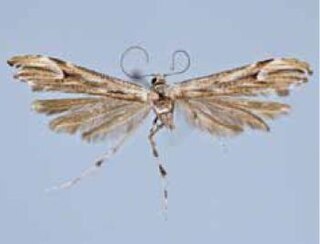
Mimas tiliae, the lime hawk-moth, is a moth of the family Sphingidae. It is found throughout the Palearctic region and the Near East, and has also been identified in Canada's east and western provinces and in northern Spain (Europe). The species was first described by Carl Linnaeus in his 1758 10th edition of Systema Naturae.

The angle shades is a moth of the family Noctuidae. The species was first described by Carl Linnaeus in his 1758 10th edition of Systema Naturae. It is distributed throughout Europe as far east as the Urals and also in the Azores, in Algeria, and in Asia Minor, Armenia, and Syria. It is strongly migratory.

Endotricha flammealis, the rose-flounced tabby, is a species of snout moth, family Pyralidae.

Deilephila porcellus, the small elephant hawk-moth, is a moth of the family Sphingidae. The species was first described by Carl Linnaeus in his 1758 10th edition of Systema Naturae. It is found in Europe, North Africa and western Asia.

Mythimna favicolor, or Mathew's wainscot, is a moth of the family Noctuidae. The species was first described by Charles Golding Barrett in 1896. It is found in Europe. The species is sometimes treated as a subspecies of Mythimna pallens, the common wainscot.

Hippotion osiris is a moth of the family Sphingidae. It is common throughout most of the Ethiopian Region, including Madagascar and the Seychelles. Occasional vagrants have been recorded from Spain. It is uncommon on the East African coast. This species is an occasional migrant.

Hippotion pentagramma is a moth of the family Sphingidae. It is known from the arid areas in Arabia, Somalia and Ethiopia.

Hippotion talboti is a moth species of the family Sphingidae. It occurs on São Tomé Island.

Apamea inficita, the lined Quaker is a moth of the family Noctuidae. The species was first described by Francis Walker in 1857. It is native to North America, where it can be found from Newfoundland west to British Columbia, north to the Yukon and the Northwest Territories, and south to Colorado.
Neopolyptychus serrator is a moth of the family Sphingidae. It is known from forests from the Congo to Uganda and western Kenya. It is also known from Cameroon.

Ceridia heuglini is a moth of the family Sphingidae. It is known from savanna and grassland from Mali and Chad to Sudan, the Central African Republic and Uganda.
Phylloxiphia oweni is a moth of the family Sphingidae. It is found from Sierra Leone east to the Central African Republic and then south to Gabon, the Republic of the Congo and the Democratic Republic of the Congo.

Phylloxiphia punctum is a moth of the family Sphingidae. It is known from savanna from north-eastern South Africa to Zimbabwe, Zambia, the Democratic Republic of the Congo and Tanzania.

Phylloxiphia metria is a moth of the family Sphingidae. It is known from Brachystegia woodland Mozambique to Zambia and the Democratic Republic of the Congo and north to Malawi and Tanzania.

Antinephele maculifera is a moth of the family Sphingidae. It was described by William Jacob Holland in 1889, and is known from Sierra Leone to the Democratic Republic of the Congo and Uganda. It is also found in Kenya, Malawi, Tanzania and Zimbabwe. It is known from forests and wooded habitats.

Theretra perkeo is a moth of the family Sphingidae. It is known from the arid areas north of the equatorial forest belt, from Senegal to northern Uganda.

Oidaematophorus phaceliae is a moth of the family Pterophoridae that is found from Yukon to Ontario, south to California and Baja, California. The habitat consists of boreal forest.

Grapholita janthinana, the hawthorn leafroller, is a moth of the family Tortricidae. It was described by Philogène Auguste Joseph Duponchel in 1843. It is found in most of Europe, except most of the Balkan Peninsula, Ukraine, Lithuania and Estonia. The habitat consists of hedgerows, gardens and woodland edges.
Apantesis williamsii, or Williams' tiger moth, is a moth of the family Erebidae. It was described by Charles R. Dodge in 1871. It is found in North America from the Northwest Territories east to the northern Great Lakes region, New Brunswick and New England. It also occurs throughout the northern Great Plains, south at higher elevations to Arizona and New Mexico, west to south-eastern British Columbia and eastern California.
Virbia ferruginosa, the rusty holomelina, is a moth in the family Erebidae. It was described by Francis Walker in 1854. It is found from Nova Scotia to British Columbia in Canada. In the United States it is found from the northeast and upper Midwest, south to Virginia, Mississippi, Missouri and Louisiana.
















